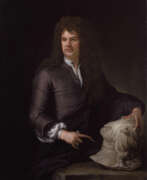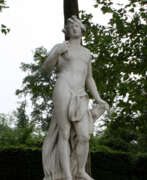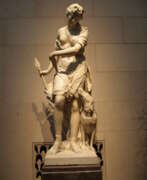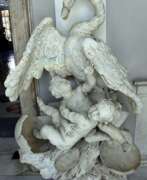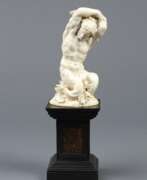Sculptors 17th century


Giovanni Lorenzo Bernini, an Italian artist, is celebrated as one of the most remarkable sculptors and architects of the Baroque era. Born in Naples in 1598, Bernini's family moved to Rome when he was a child, where he spent most of his life shaping the city's artistic landscape. His prodigious talent emerged early, evident in works created in collaboration with his father, Pietro Bernini, and soon caught the attention of influential patrons like Cardinal Scipione Borghese and Pope Paul V.
Bernini's work, characterized by dynamic and exuberant style, spanned various genres including portraiture, tomb sculpture, and religious and mythological representations. His ability to turn marble into lifelike figures and scenes, blending realism with emotional intensity, was unparalleled. Key works like "Aeneas and Anchises," "Pluto and Proserpina," and "Apollo and Daphne" exemplify this mastery.
Not confined to sculpture, Bernini was also an accomplished architect, contributing significantly to the architectural landscape of Rome. His involvement with St. Peter's Basilica, notably the Baldacchino and the design of St. Peter's Square, reflect his vision of merging architecture with sculpture to create a cohesive and impactful experience. His work on the Cornaro Chapel, including the famous "The Ecstasy of Saint Teresa," showcases this integration, combining sculpture, architecture, and light to stunning effect.
Bernini's influence extended beyond Rome. In 1665, he was invited by Louis XIV to France to work on the Louvre, though his architectural designs were not realized. His portrait bust of Louis XIV, however, remains a testament to his skill in capturing not just the likeness but the essence of his subjects.
A man of deep faith, Bernini's works often reflected his religious devotion, though he was also known for his caricatures and playful sketches, revealing a lighter side to his personality. His artistic legacy, characterized by the fusion of various art forms and the dramatic use of light and space, continues to influence and inspire.
For collectors and experts in art and antiques, Bernini's works remain a pinnacle of Baroque artistry, a testament to his innovative spirit and technical brilliance. His pieces, found in museums and galleries, continue to draw admiration for their emotional depth and exquisite craftsmanship.
Stay updated on new discoveries and sales of Bernini's works by signing up for our newsletter, exclusively focused on his art and upcoming auction events.
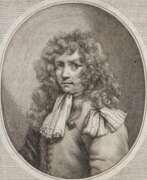

Thomas Blanchet, a distinguished French painter, sculptor, and architect, left an indelible mark on the Baroque era with his multifaceted talent. Blanchet's journey in art saw him transitioning from sculpture to painting under the guidance of Jacques Sarazin. His early years in Paris were enriched by the emerging Baroque influence and the Mannerism of the School of Fontainebleau, placing him among contemporaries like Simon Vouet.
Blanchet's formative years extended beyond French borders, as he ventured to Rome around 1645 to 1653. There, he immersed himself in the circle of Nicolas Poussin and visited the studios of Andrea Sacchi and Pietro da Cortona, earning high praise from Gianlorenzo Bernini. This period was marked by significant commissions, including works for Niccolò Guido di Bagno and the creation of engravings and mausoleums, notably in Venice for René de Voyer d'Argenson.
His repertoire was vast, encompassing classical themes, religious narratives, and architectural capriccios, as evidenced in works like "Time and Truth overcoming Envy and Discord" and "La Résurrection De Lazare". Blanchet's influence extended to Lyon, where he contributed to the city's cultural heritage through frescoes at the Collège de la Trinité, now Collège Ampère, and designed significant public and private spaces including the Palais de Roanne's grand chamber ceilings.
For collectors and experts in art and antiques, Thomas Blanchet's oeuvre represents a bridge between French and Italian Baroque, embodying the era's dramatic expressions and classical reverence. His works, found in both public spaces and museums, continue to be celebrated for their historical and artistic significance.
To stay informed about exhibitions, sales, and auctions related to Thomas Blanchet's works, signing up for our newsletter is recommended. This subscription ensures access to the latest insights and opportunities related to this Baroque master's enduring legacy.


Alonso Cano was a multifaceted Spanish artist, renowned for his remarkable contributions in painting, sculpture, and architecture. Born in Granada in 1601, Cano is often celebrated as the "Spanish Michelangelo", a testament to his diverse artistic talents and significant impact on the Baroque era. His career, marked by a blend of Italian Mannerism and Baroque style, was a journey through various Spanish cities, each phase contributing uniquely to his artistic evolution.
In Seville, Cano trained under Francisco Pacheco, where his initial works like "San Francisco de Borja" (Seville Museum of Fine Arts) displayed a blend of Tenebrism and a brighter, more lyrical color palette. This period also saw the birth of works like "La Visión de San Juan" (Wallace Collection, London), signaling a transition in his style. Madrid, however, marked a significant turn in Cano's career. His works for the Buen Retiro Palace and the Alcázar showcase an evolution towards elegant, dynamic Baroque forms with lighter tonalities, influenced by the 16th-century Venetian masters.
Cano's return to Granada in 1652 was a homecoming that not only reinvigorated the Granada School but also marked his most prolific period. His masterpieces during this time include the series of paintings on the life of the Virgin in Granada Cathedral, a remarkable testament to Baroque art. Notably, his "Inmaculada Concepción" (1648) and "Nacimiento de la Virgen" (1663-1664) in the Cathedral stand as crowning achievements of his painterly career.
Equally impressive is Cano's sculptural work, where his polychrome wooden statue of the Immaculate Conception (1655) in Granada Cathedral is often hailed as his magnum opus. Despite sculpture being a secondary focus to his painting, his works, such as the Inmaculada in San Julián Church, Sevilla, and the smaller, yet exquisitely crafted, Inmaculada of the facistol in Granada Cathedral, resonate with the delicate beauty pointing towards Rococo art.
Cano's architectural prowess is exemplified in the design of Granada Cathedral's façade, an original piece of Spanish Baroque architecture. His artistic journey was not just a personal endeavor but a pivotal influence in the transition of Spanish painting towards a more idealist trend alongside Velázquez.
For art collectors and experts, Alonso Cano's works remain a cornerstone of the Baroque era, showcasing a blend of dramatic realism and spiritual depth. His influence extends beyond the boundaries of Granada, leaving an indelible mark on the world of art and culture.
To stay informed about new discoveries, product sales, and auction events related to Alonso Cano's works, sign up for our updates. This subscription focuses solely on providing relevant news in the art and antiques realm, especially concerning Cano's invaluable contributions.


Lodovico Carracci was a significant Italian painter and printmaker from Bologna, renowned for his contributions to Baroque art and the Bolognese school. He was a pivotal figure in reinvigorating Italian art, particularly fresco art, which had been overshadowed by the formalistic Mannerism of the late Renaissance period.
His works are distinguished by their emotional depth and spiritual intensity, often achieved through bold gestures and dramatic lighting. As an artist, he was instrumental in establishing the Carracci workshop and style, alongside his cousins Agostino and Annibale Carracci. Together, they founded an art academy in Bologna around 1585 that focused on a naturalistic approach to painting, emphasizing life drawing and a return to classical principles.
Lodovico Carracci was known for his skillful use of colour and his ability to create harmonious and balanced compositions. His works often depicted religious and mythological subjects and he was particularly famous for his frescoes, which adorned many churches and palaces in Bologna. He was also an influential teacher, with Guido Reni and Domenichino among his pupils.
Among Carracci's known works are notable religious compositions like "The Lamentation" and "Madonna and Child with Saints," which are now housed in prestigious museums such as The Metropolitan Museum of Art in New York. He also worked on significant fresco cycles in private palaces, such as the cycle depicting the story of Jason and the Argonauts in the Palazzo Fava, completed in 1584.
If you'd like to stay updated on new art-related product sales or auction events featuring works by Lodovico Carracci, consider signing up for updates to receive notifications about upcoming events and sales. This subscription is exclusively for receiving alerts on art and auction news related to Carracci's works and does not include promotional materials unrelated to art.


Guillaume Coustou the Elder was a French sculptor of the Baroque and Louis XIV style. He was a royal sculptor for Louis XIV and Louis XV and became Director of the Royal Academy of Painting and Sculpture in 1735. He is best known for his monumental statues of horses made for the Chateau of Marly, whose replicas now stand in the Place de la Concorde in Paris.


Giovanni da Bologna, also known as Jean de Boulogne (French), Giambologna (Italian), Fiammingo (Italian) and Jehan Boulongne (Flemish), was the last significant Italian Renaissance sculptor, with a large workshop producing large and small works in bronze and marble in a late Mannerist style.


Romeyn de Hooghe was a Dutch painter, sculptor, engraver and caricaturist of the late Baroque period, writer and philosopher.
Hooghe became famous for his political caricatures of King Louis XIV of France and propaganda pamphlets in support of William of Orange. He portrayed the war against the French monarch and his allies as a struggle between freedom and religious despotism.
Romeyn de Hooghe was a superb engraver and created over 3,500 engravings during his lifetime. His most important work is Hieroglyphica of Merkbeelden der oude volkeren (Hieroglyphics or Symbols of the Ancient Peoples), where he appeared not only as a consummate master of engraving, but also as a historian, talented writer and philosopher. This book has long been regarded in Europe as one of the most authoritative sources on classical mythology. It contains 64 engravings illustrating all stages of the narrative of myths, ancient cults and beliefs, and the interpretation of scripture, a guide to medieval Europe.
Romeyn de Hooghe also illustrated books and painted large panels. During his lifetime he was widely recognized as a painter and sculptor not only in his own country but also in other European countries.


Pedro de Mena y Medrano, baptized in August 1628 in Granada, Spain, and passing in October 1688 in Málaga, was a distinguished Spanish sculptor renowned for his emotionally charged religious sculptures. His works, primarily executed in polychromed wood, are celebrated for their incredible realism and detail, bringing a tactile and visceral presence to religious figures.
Mena's education in sculpture began under the guidance of his father, Alonso de Mena, and further honed by the teachings of Alonzo Cano. His early success was marked by contributions to the convent of St. Anthony in Granada, showcasing figures of notable saints. His significant commission for the cathedral of Málaga in 1658, involving sculptural work on the choir stalls, extended his reputation beyond his initial local fame.
Pedro de Mena is lauded for his technical mastery and the emotional depth of his work, which includes celebrated pieces such as "Ecce Homo" and "Mater Dolorosa." These works exemplify his skill in using polychrome wood to achieve lifelike representations of religious figures, engaging viewers with their expressiveness and detail. His sculptures often featured intricate details such as real human hair, glass eyes, and tears made of resin, enhancing their lifelike appearance and evoking a strong emotional response from the beholder.
Mena's legacy is firmly entrenched in the Spanish Baroque tradition, with his sculptures found in various churches and museums, including the National Museum of Sculpture in Valladolid. His artistry continues to captivate collectors and art enthusiasts, representing a pinnacle of religious sculpture during the Baroque period.
For those interested in the profound spiritual and artistic depth of Pedro de Mena's work, signing up for updates can enrich your understanding and appreciation of his contributions to the world of art. Stay informed about new product sales and auction events related to Pedro de Mena and immerse yourself in the world of Spanish Baroque sculpture.


Juan de Mesa y Velasco was a Spanish Baroque sculptor born in 1583 in Córdoba and died in 1627 in Seville. He is renowned for creating several effigies used in Holy Week processions in Seville, showcasing his masterful approach to religious art during the Baroque period. Mesa was a prominent disciple of Juan Martínez Montañés, embodying the transition from Renaissance ideals to Baroque emotion and realism.
His work is distinguished by its realistic portrayal of human anatomy, intense expression, and dramatism, particularly evident in his crucified Christ figures. These sculptures not only convey the physical torment of Christ but also embody a deep spiritual passion, aligning with the Catholic Church's post-Tridentine mandates for art to be accessible and educative for the faithful. Among his notable works are the Cristo de la Buena Muerte and Jesús del Gran Poder, which remain central to Seville's Holy Week celebrations and are celebrated for their emotional depth and realism.
Despite his premature death at 44, possibly due to tuberculosis, Mesa's legacy endures through his sculptures, which continue to be objects of devotion and admiration. His ability to capture the intensity of biblical narratives and the human form has made him a pivotal figure in Spanish Baroque sculpture, with works held in high regard and still influencing the tradition of religious procession figures in Spain.
For collectors and experts in art and antiques, Mesa's work represents a peak of Baroque sculptural art, imbued with spiritual depth and technical mastery. To stay informed about new discoveries and auction events related to Juan de Mesa y Velasco, signing up for updates is recommended. This ensures access to the latest sales and insights into the enduring legacy of this Baroque master.


Jose de Mora was a Spanish sculptor renowned for his contributions to Baroque art. Born in Baza in 1642, Mora was the eldest son of sculptor Bernardo de Mora and notably a pupil of Alonso Cano. His career was distinguished early on when he moved to Madrid in 1669, two years after Cano's death, to work with Sebastián de Herrera Barnuevo, another of Cano's pupils. Mora's reputation was further solidified in 1672 when he became a sculptor for King Charles II, highlighting his significance in the Spanish royal court.
Mora's work is celebrated for its expressive minimalism and austere style, a deviation from his mentor Cano's approach, yet achieving a distinct artistic effectiveness. His sculptures, particularly those of religious figures, are characterized by a unique blend of realism and emotion, making them profound objects of devotion. Notable works include the Christ of Mercy and Our Lady of Sorrows in Granada, among others found in the cities of Jaén, Seville, Valladolid, and Córdoba.
One of Mora's masterpieces, the Virgin of Sorrows, is held in high esteem for its technical virtuosity. This painted pinewood bust, adorned with ivory and glass to achieve lifelike details, exemplifies Mora's skill in using realistic details to evoke emotional resonance. This piece, among others, underscores Mora's contribution to Spanish Baroque sculpture and his ability to convey intense emotion through his art.
Mora's legacy is preserved in various collections, including the Victoria and Albert Museum, which houses his bust of the Virgin of Sorrows. His works continue to be a focal point for scholars and enthusiasts of Baroque art, as seen in exhibitions and the digital archives of Wikimedia Commons, offering insight into his contributions to the art world.
For art collectors and experts seeking to delve deeper into the works of Jose de Mora, signing up for updates on new sales and auction events can offer exclusive access to acquiring pieces by this eminent sculptor. This subscription will ensure that enthusiasts are well-informed about opportunities to own a part of Spanish Baroque history.


Pieter de Neyn or Deneyn was a Dutch painter of the Golden Age.
In his youth he worked as a stonemason, but an acquaintance with painters gave him the opportunity to learn the basics of painting. De Neyn was known for landscapes featuring villagers at work and also painted battle scenes. He was also a city sculptor in Leiden.


Juan de Valdés Leal, born on May 4, 1622, in Seville, Spain, and passing away on October 15, 1690, was a Spanish painter and etcher celebrated for his Baroque era works. Valdés Leal is recognized for his dramatic and often somber thematic paintings which starkly contrasted with the serene styles of his contemporaries. His notable contributions include not just painting but also sculpture and architecture, indicating his versatile artistic talents. Educated under Antonio del Castillo in Córdoba, Valdés Leal's body of work covers religious and vanitas themes, emphasizing the transient nature of earthly life and the inevitability of death.
One of Valdés Leal's significant periods was after his return to Seville in 1656, where alongside Bartolomé Esteban Murillo, he co-founded the Seville Academy of Art. This period marked the creation of some of his most poignant works, including "In ictu oculi" and "Finis gloriae mundi," which he painted for the Charity Hospital in Seville. These works are revered for their deep contemplation on mortality and the fleeting nature of worldly success.
Valdés Leal's legacy extends beyond his own lifetime, with several of his children, including Lucas, Juan, Maria, and Laura, following in his artistic footsteps. His influence persisted in Seville's artistic landscape, especially in religious art, where his pieces continued to inspire both awe and reflection.
For collectors and experts in art and antiques, Juan de Valdés Leal's work offers a profound glimpse into the Baroque era's complex interplay of beauty, spirituality, and the macabre. His paintings, many of which reside in museums and private collections worldwide, remain a testament to his skill and depth as an artist.
To stay updated on sales and auction events related to Juan de Valdés Leal's works, signing up for updates can provide exclusive access to the latest available pieces and related events, ensuring enthusiasts and collectors don't miss out on acquiring or viewing works by this illustrious artist.


Antonio del Castillo y Saavedra was a Spanish Baroque painter, sculptor, and poet, renowned for his significant contributions to the Cordoba School of art. Born in Cordoba, Spain, in 1616, Castillo y Saavedra grew up under the influence of his father, Agustín del Castillo, also a painter. His early education continued under Ignacio Aedo Calderón, and later, in Seville, he studied with Francisco de Zurbarán and his uncle Juan del Castillo.
Castillo y Saavedra's work is distinguished by its adherence to naturalism, a style he maintained despite the evolving Baroque trends of his time. His landscapes and narrative paintings, often featuring elaborate architectural or landscape settings, showcase his unique spatial sense and meticulous studies of nature. Praised as an "excellent landscape painter" by his contemporaries, Castillo y Saavedra was adept at capturing nature's essence and integrating it seamlessly into his historical oil paintings. His works, such as the Calvary of the Inquisition and the series on the life of Joseph, exhibit a luminous sense of landscape with refined color palettes.
Some of his most celebrated works are housed in prestigious institutions around the world. The Museo del Prado in Madrid, Spain, holds an impressive collection of his paintings, including the notable series on the story of Joseph. The Museo de Bellas Artes de Córdoba also features his significant works, like the Calvary of the Inquisition.
Despite his death in 1668, Castillo y Saavedra's legacy lives on through his contributions to the Cordoba School, influencing generations of artists who followed. His work remains a testament to the rich cultural heritage and artistic prowess of the Spanish Golden Age.
For collectors and experts in art and antiques, Antonio del Castillo y Saavedra's works represent a pinnacle of Baroque art. To stay informed about new sales and auction events related to Castillo y Saavedra's work, we invite you to sign up for our updates. This subscription will keep you at the forefront of the latest developments in this fascinating field.


Martin Desjardins, born Martin van den Bogaert, was a French sculptor of Dutch origin who became famous and successful in Paris. He was royal court sculptor under Louis XIV and rector of the French Academy of Painting and Sculpture.


Ignaz Elhafen was an Austrian Baroque sculptor.
Ignaz Elhafen was born in Innsbruck, where he received an artistic education: he learned the art of woodcarving. Then in Rome he perfected his skills in the artistic processing of ivory. Later he worked as court painter for the Elector in Düsseldorf.


Gregorio Fernández was a Spanish Baroque sculptor, celebrated for his profound impact on religious art during the 17th century. Born in Sarriá, Lugo, in 1576 and later settling in Valladolid, Fernández became a pivotal figure in the Castilian school of sculpture. His works are renowned for their dramatic expressiveness and intricate detail, capturing both physical and moral pain alongside mystical experiences through the serene poses and expressive faces and hands of his figures. The realism in his sculptures was further enhanced by the use of glass for eyes, ivory for nails and teeth, and other materials to add authenticity.
Valladolid's artistic environment, shaped by the Counter-Reformation and the legacy of architects like Juan de Herrera, played a crucial role in Fernández's development. His sculptures for altarpieces and processional "pasos" like the famous "Camino del Calvario" are notable for their blending of naturalistic detail and classical support structures, creating a dynamic interplay of form and religious narrative.
Fernández's mastery is evident in a range of works, from the serene "Pietà" to the detailed "Cristo Yacente," and his influence extended across Spain, from Madrid to Galicia and Extremadura. His collaboration with painters on the polychrome of statues added a vibrant dimension to the sculptures, enriching their emotional impact.
For collectors and experts in art and antiques, Fernández's contributions to the Spanish Baroque period exemplify the height of religious sculpture, blending technical skill, emotional depth, and theological significance. His legacy continues to inspire and resonate within the art world, with many of his works preserved in museums and galleries, including the Museo Nacional de Escultura in Valladolid.
If you're passionate about the art of Gregorio Fernández and wish to explore his works further, consider signing up for updates on new product sales and auction events related to this remarkable sculptor. Stay informed and enrich your collection with pieces that celebrate his enduring legacy.


Giovanni Battista (Giambattista) Foggini was an Italian sculptor active in Florence, renowned mainly for small bronze statuary.
Foggini's pupils included Fernando Fuga, his nephew Filippo della Valle, Balthasar Permoser, Giovacchino Fortini and Giovanni Baratta. Massimiliano Soldani Benzi was a contemporary student with Foggini in Rome and also active in small bronze sculpture.


Gabriël Gruppello was a Flemish Baroque sculptor who produced religious and mythological sculptures, portraits and public sculptures. He worked in Flanders, France and Germany. He was a virtuoso sculptor who enjoyed the patronage of several European rulers.


Meinrad Guggenbichler, also Johann Meinrad Guggenbichler, was a sculptor.
He worked as a stone sculptor and from the 1670s he created altars, church utensils and sculptures for churches and monasteries in Switzerland and Austria, as well as statues of famous personalities.


Pierre Le Gros was a French sculptor of the late seventeenth and early eighteenth centuries. He is known as a representative of the Baroque style and a master of the religious genre. His best sculptures were created on the orders of the Catholic Church.
Pierre Le Gros had a close "genetic" connection with art on both his father's and mother's side. His father, a court sculptor of King Louis XIV, had the same name (which is why Pierre Le Gros is often referred to as "the Younger"). His two maternal uncles, Gaspard and Balthazard Marsy, and his half-brother Pierre Lepautre were sculptors.
Pierre Le Gros was rejected in his homeland, but managed to achieve great professional success in Italy, where today you can see most of his work.


Francis Lepipre was an English painter of Flemish origin. Lepipre travelled extensively on the continent and his close study of the works of the great artists made him an excellent draughtsman.
Francis Lepipre painted landscapes, humorous compositions and caricatures, often carving subjects into silver plates for his friends, who used them as lids for tobacco boxes.


Juan Martínez Montañés, born on March 16, 1568, in Alcalá la Real, Jaén, Spain, and passing away on June 18, 1649, was a luminary of the Spanish Baroque sculpture scene, heralded as "el Dios de la Madera" (the God of Wood) for his unrivaled mastery in wood carving. His contributions significantly shaped the Sevillian school of sculpture, where he introduced the innovative encarnación technique, imbuing his wooden sculptures with lifelike skin tones.
Montañés is celebrated for his exceptional naturalism and precision in depicting human anatomy, setting him apart from many contemporaries. His works, characterized by their graceful forms and devout expressions, often encapsulated the religious fervor of the era. Notable pieces include the highly revered 'Saint John the Baptist', showcased at The Metropolitan Museum of Art, and 'Cristo de la Clemencia', housed in the Seville Cathedral, each illustrating his skillful handling of wood and keen attention to anatomical detail.
Throughout his life, Montañés enjoyed significant acclaim, not only within Spain but also internationally, with some of his works making their way to the Spanish Americas. This broad recognition is a testament to his influence on and contribution to the Baroque artistic movement. His legacy persisted through his students, including notable figures such as Juan de Mesa, and through his son, Alonzo Martínez, ensuring the continuation of his stylistic and technical innovations in sculpture.
For collectors and art and antiques enthusiasts, Montañés's works remain pivotal, embodying the spiritual and artistic zeitgeist of 17th-century Spain. His sculptures are not just artistic marvels but also cultural artifacts that offer insights into the era's religious and social contexts.
To stay informed about exhibitions featuring Juan Martínez Montañés's works or upcoming auction events related to this pivotal figure in Baroque sculpture, consider signing up for updates. This subscription ensures you're always in the know about opportunities to engage with Montañés's enduring legacy.




Domenico Parodi was an Italian late Baroque painter, sculptor, and architect.
His father was the famous Genoese sculptor Filippo Parodi and the painter Giovanni Battista Parodi was his younger brother.
Parodi is known for his fantastic decorative ceilings in religious buildings and palaces depicting mythological and allegorical subjects. He created commissioned busts and portraits, tombstones, altars, and sculptures. He also continued the sculptural tradition of his father, carving figures of Apollo, Ariadne, Bacchus and Diana in marble in elaborate techniques.
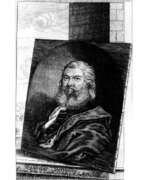

Balthasar Permoser was a German sculptor of the seventeenth and eighteenth centuries. He is known as a brilliant representative of the Late Baroque era in the history of European art. Several hundred of Permoser's masterpieces made from the most varied materials have survived. The artist's biography is closely connected with Dresden, where he lived most of his life.
Balthasar Permoser is considered one of the founders of the Southern German style of sculpture. For more than forty years he ran a huge workshop, in which dozens of assistants worked continuously on the creation of statues and reliefs.
Permoser created works of all sizes from marble, sandstone, wood, ivory, fired clay, plaster and silver. Hundreds of apprentices passed through his Dresden workshop, but none of them could surpass their teacher in the level of recognition.


Giulio Cesare Procaccini was an illustrious Italian painter and sculptor of the Baroque period, celebrated for his dynamic and expressive works. Born in Bologna and later moving to Milan, Procaccini's artistry was deeply influenced by the emotional intensity of Mannerism and the vibrant colorism of Venetian painting, signaling the dawn of the Baroque era.
Procaccini's oeuvre includes significant altarpieces such as the "Circumcision" now in the Galleria Estense in Modena, and the "Last Supper" for the Basilica della Santissima Annunziata del Vastato in Genoa. His collaboration with artists like Giovanni Battista Crespi and Pier Francesco Mazzucchelli under the patronage of Cardinal Federico Borromeo highlighted his pivotal role in the Milanese art scene. Moreover, Procaccini's "Ecce Homo" at the Dallas Museum of Art and "The Agony in the Garden" at the Prado Museum in Madrid exemplify his mastery in depicting religious narratives with profound emotion and technical sophistication.
Procaccini's journey through the art world was marked by his initial work as a sculptor, later transitioning to painting, where he left a lasting legacy. Commissioned to paint scenes commemorating the life of Cardinal Carlo Borromeo in Milan Cathedral, his style evolved to exhibit increased clarity and a brighter palette, indicative of his maturation as an artist. His exposure to the works of Rubens and his travels across Italy allowed him to absorb and reinterpret the stylistic elements of Caravaggio, Correggio, and Parmigianino, enriching his own artistic language.
Though not represented in London's National Gallery, Procaccini's paintings grace collections across Europe and beyond, with notable works in the north of England, including "The Mocking of Christ" at Museums Sheffield and "The Raising of the Cross" at the National Galleries of Scotland. These pieces demonstrate his skillful use of color and ability to convey the physical and emotional weight of biblical stories.
For collectors and experts in art and antiques, Giulio Cesare Procaccini represents a fascinating study in the transition from Mannerism to Baroque, embodying the emotional depth and innovative spirit of early 17th-century Italian art. His contributions to the Baroque period remain a testament to his versatility and enduring appeal.
For updates on new discoveries, sales, and auction events related to Giulio Cesare Procaccini, consider signing up for relevant newsletters or alerts. This ensures that enthusiasts and collectors alike are well-informed about the latest opportunities to engage with the magnificent art of Procaccini.


Luisa Ignacia Roldán Villavicencio, known as La Roldana, was a Spanish sculptress of the Baroque period and the first female sculptor in Spain about whom there is verified lore. In the Museum of the Latin American Society, Roldán is described as "one of the few female artists who had their own workshop outside the convent in Golden Age Spain". Her father Pedro Roldán was also a sculptor from Seville.


Giuseppe Rusnati was a Lombard sculptor of the Rococo period. Known for having trained with Ercole Ferrata and subsequently from 1673 to c. 1686 training a young Camillo Rusconi, prior to the latter's relocation himself to Ferrata's studio in Rome. He worked for many years for the Duomo of Milan, where he worked along with Giuseppe Buono and Carlo Simonetta.


Jean-Baptiste Santerre was a French painter and draughtsman of the Style Louis XIV, known for his history paintings, portraits, and portrait-like genre subjects. Considerably influenced by Italian masters of the Bolognese school as well as his French contemporaries, Santerre nonetheless made an original contribution in his art, being among the first French painters to bring Netherlandish influences.
After achieving initial success as a portrait painter by the late 1690s, Santerre began to branch out into the fields of genre painting and, in which he combined the fantasy portrait of Northern tradition, as seen in the art of Rembrandt and Gerrit Dou, with the allegorical portrait, then fashionable in France. At the same time, he also painted history paintings and altarpieces of biblical and religious subjects, suffused with a strong erotic character.
Santerre's work brought him a controversial reputation, in light of his association with the French Regency era; it was during the 19th and 20th centuries when it met a broader appreciation. Santerre is regarded as a precursor of the Rococo era painting, as well as of both Neoclassical and Romantic painting, and was said to be an influence on subsequent generations of artists during the said eras.


Massimiliano Soldani or Massimiliano Soldani Benzi was an Italian baroque sculptor and medallist, mainly active in Florence. Soldani developed into one of the finest bronze casters of his time in Europe. Though first specialising as a medallist, Soldani also produced bronze reliefs, bronze vases and free-standing figures and busts.


Jacob van der Heyden was a Flemish Baroque painter, sculptor and engraver. According to Houbraken he was a painter from Strasbourg who painted for royalty. According to the RKD he worked in Strasbourg, Frankfurt, and Sweden. and was known for portraits, landscapes and historical allegories. Most of his work that survives today are engravings. He died in Brussels.


Rombout Verhulst was a Flemish sculptor and draughtsman, one of the representatives of Dutch Baroque sculpture. Verhulst is best known for his numerous tombstones, but he also created portrait busts, garden sculptures, and small ivory works.






































